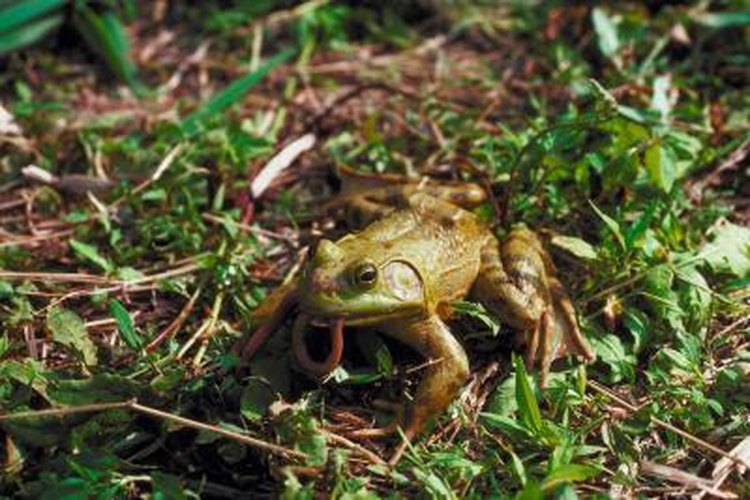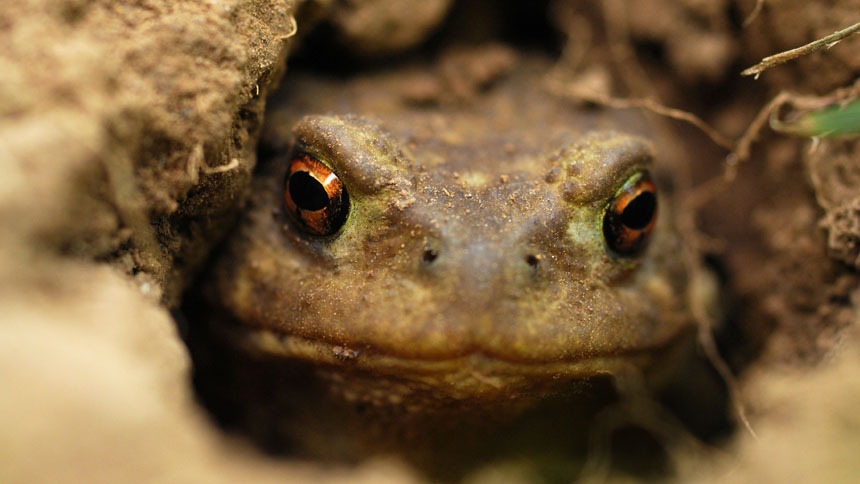A tiny toad with glistening eyes disappearing beneath the soil or a frog vanishing into an underground chamber hidden from prying eyes. It’s a curious sight that prompts questions about their motivations and instincts. Frogs and toads burrow have long intrigued scientists and nature enthusiasts alike, leading to a quest for understanding their underground activities.
These fascinating amphibians, often associated with hopping around lily pads and croaking at night, actually have a lesser-known behavior of digging into the ground.
6 Reasons That Frogs And Toads Burrow
Frogs and toads burrow to stay safe from predators. They make a safe place underground to rest and lay eggs. This shows how they can adapt and find shelter to survive. Burrowing helps them control their body temperature. They can stay cool in hot weather and find warmth when it’s cold. This helps them keep their body processes working well.
Burrowing also helps them find water and food. In dry places, they dig tunnels to find damp areas where they can drink water and find small creatures to eat. This shows how they can use underground resources to stay fed and hydrated when the surface is not good.
Reason 1: Hibernation
Frogs and toads are known for their ability to burrow themselves into the ground for hibernation, a behavior that has fascinated scientists for decades. While many animals migrate or seek shelter in cold weather, these amphibians dig deep into the earth to survive the harsh winter. Research suggests that burrowing provides an insulating layer of protection against freezing temperatures, allowing them to conserve energy and remain dormant until spring.
They can escape the watchful eyes of hungry birds and predators looking for an easy meal. This strategic behavior not only ensures their survival but also highlights their remarkable instincts for self-preservation. The intricate ways in which they have evolved to endure and flourish in diverse habitats.
Reason 2: Estivation
They burrow for estivation as a survival mechanism to escape extreme temperatures, conserve energy, and protect themselves from predators. By digging deep into moist soil or mud, these amphibians create a relaxed and safe environment where they can remain dormant throughout the dry season. This underground retreat shields them from dehydration and heat stress, allowing them to enter a state of torpor until more favorable conditions return.

Some species of frogs and toads have evolved special anatomical features that make burrowing for estivation more efficient. Their rounded bodies and specialized pelvic muscles enable them to excavate tunnels efficiently, while their permeable skin helps maintain moisture levels during extended periods of inactivity.
Reason 3: Low Humidity
Frogs and toads are renowned for burrowing during periods of low humidity, which confounds many. While these amphibians are primarily associated with moist environments, their ability to burrow into the soil allows them to regulate their moisture levels. By digging underground, they can escape the drying effects of the air and maintain an optimal level of hydration. This adaptive behavior also protects from predators and extreme temperatures, demonstrating the ingenious ways these creatures have evolved.
Burrowing helps frogs and toads access food sources not available on the surface. Invertebrates such as earthworms and insects often dwell in damp soil, making it an abundant hunting ground for these amphibians. By engaging in this behavior, frogs and toads demonstrate their versatility and resourcefulness when faced with adverse environmental conditions.
Reason 4: Hiding From Predators
Frogs and toads are experts at using their environment to evade predators, and burrowing is a common tactic they employ. This instinctive behavior allows them to find refuge from danger, whether a hungry bird or a prowling mammal. Returning underground enables these amphibians to remain out of sight, giving them the precious time they need to escape harm’s way. The damp and cool conditions within the burrow also protect from extreme temperatures and help maintain their moisture levels.

Offering safety from predators, burrowing is an effective strategy for frogs and toads to find shelter during adverse weather conditions. Heavy rain and intense heat can pose severe threats to these creatures, so having a cozy retreat below ground offers them respite from such unfavorable circumstances. Burrowing helps these amphibians minimize energy expenditure by reducing the need for constant movement above ground, allowing them to conserve vital resources for survival.
Reason 5: Ambushing Prey
Frogs and toads are masters of camouflage and ambush when hunting for their prey. Burrowing into the ground allows them to remain inconspicuous, hiding from predators and potential prey. This unique behavior also provides a strategic advantage in ambushing unsuspecting insects and small animals that pass by their burrows. By burying themselves in the soil, frogs and toads become virtually invisible, giving them the element of surprise when targeting their next meal.
The underground environment offers a stable microclimate, protecting them from extreme weather conditions and providing a moist habitat for survival. Burrowing enables frogs and toads to create secure nesting sites to lay eggs without constant disturbance from predators or external threats. This natural behavior demonstrates how these remarkable creatures have evolved ingenious ways of hunting and ensuring their survival in challenging environments.
Reason 6: Good Acoustics
Frogs vs toads make their homes underground for many reasons, including surprisingly good acoustics. These amphibians rely on their calls to attract mates and defend territory, so the acoustic properties of their burrows play a significant role in communication. Studies have shown that the soil composition in these underground habitats can enhance sound transmission, allowing frog vs toad calls to travel further and be more effectively heard by potential mates or rivals.

The shape and structure of burrows also contribute to improved acoustics for these creatures. The natural contours and materials within the burrow can act as sound reflectors, amplifying the vocalizations made by toads vs frogs. Being tucked away from external noise sources makes their calls more easily discernible within these underground chambers. This phenomenon sheds light on the intricacies of animal communication.
My Frog Is Burrowing In The Substrate, Should I Worry?
If you’ve noticed your frog burrowing in the substrate of its enclosure, it’s natural to wonder whether this behavior is cause for concern. Burrowing behavior is standard and often a sign that your frog feels comfortable and secure in its environment. Frogs and toads are known for their instinct to burrow to seek shelter, regulate body temperature, and even hunt for food. Many species of frogs have specialized adaptations, such as modified feet or strong limbs, that enable them to dig into the substrate effectively.

It’s essential to recognize that burrowing is an innate behavior for many frog species and not necessarily indicative of health issues or stress. It’s always a good idea to ensure that the substrate in their enclosure is appropriate for burrowing and doesn’t pose any potential harm, such as sharp debris or toxic materials. Providing a suitable environment with plenty of hiding spots and moisture can encourage your frog’s natural behaviors while ensuring their well-being. Observing your frog exhibit its instincts should be seen as a positive sign of contentment in its habitat rather than a cause for alarm.
Final Thoughts
The frogs and toads burrow serves multiple vital purposes in their survival and reproductive efforts. Burrowing protects them from predators, extreme temperatures, and dehydration, enabling them to thrive in various habitats. It offers a safe location for hibernation and egg-laying. Understanding the ecological significance of burrowing behavior can help us better appreciate and conserve these unique amphibian species. By continuing to study and protect their habitats, we can ensure the continued existence of these fascinating creatures for generations to come.